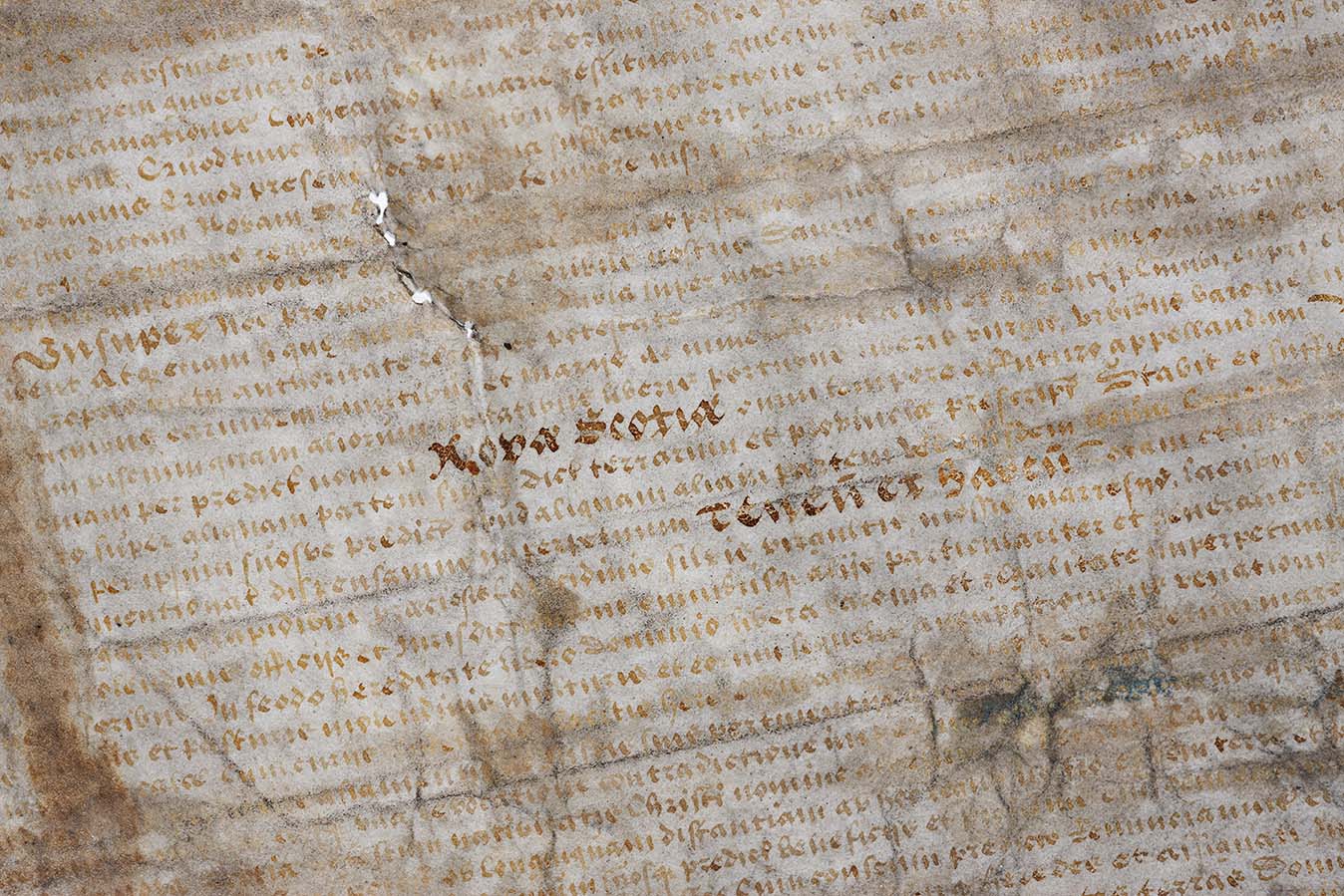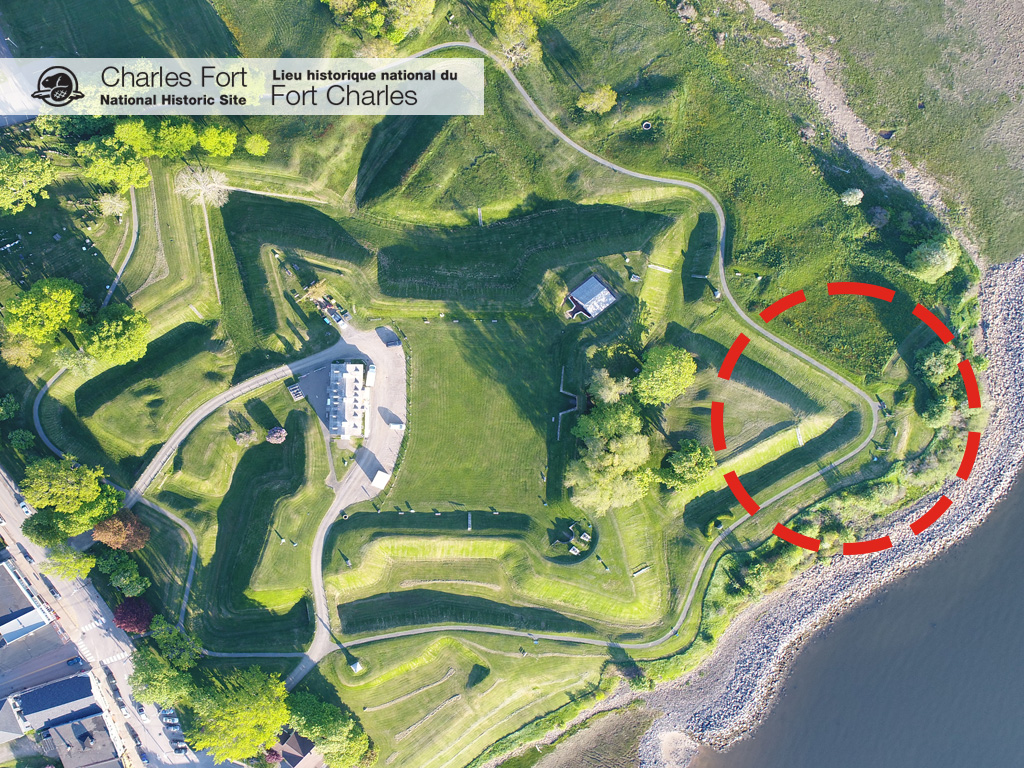Site history
Fort Anne National Historic Site
A group of about 70 Scottish settlers began a colony at Charles Fort from 1629 to 1632.
Charter of 1621

In 1621, as part of European expansion overseas, James I of England and VI of Scotland granted Sir William Alexander, a Scottish noble, a charter for New Scotland - “Nova Scotia” - to establish a Scottish colony in North America.
The charter covered the geographic area made up today of the Maritime Provinces and the Gaspé peninsula. At the time, the French claimed part of the region as Acadia while the Mi'kmaq knew it as their traditional lands, Mi'kmaki.
The charter gave Alexander rights to minerals and fisheries; the power to make laws, form a government, stop pirates, and seek peaceful relations with Native people; as well as permission to build one or more forts.
It would be eight years before a colony was established, but in 1625, the year Charles I became king, a coat of arms was approved for New Scotland. Four hundred years later, in the 1920s, the flag and arms of the Province of Nova Scotia were adopted using the 1625 heraldry as their basis and inspiration.
Scottish colonies
In 1629, eight years after the granting of a charter to establish the colony and four years after the approval of a coat of arms, Sir William's son, Sir William Alexander the younger, brought a group of 70 men and women to colonize New Scotland.
A second party, led by Sir James Stewart of Killeith, Lord Ochiltree, and comprised of English settlers, established a colony at Baleine, Cape Breton, a few miles north of where the French would later establish Louisbourg. There, they built Fort Rosemar, only to have the French destroy the settlement two months later.
Charles Fort
Meanwhile, Alexander, with the assistance of Claude de Saint-Étienne de La Tour, established his headquarters at Port-Royal (renamed Annapolis Royal by the British after 1713). There, he oversaw the construction of Charles Fort, named in honour of King Charles I.
Designed by Captain Ogilvie, the fort was “in forme of a pentagonon, with many horne works good both for offence and defence.” It mounted eight pieces of ordnance - “four demie culvering and foure minion.” The settlers and ships' crews also erected a house for Alexander and a storehouse.
During the first winter, 30 of the 70 Charles Fort settlers died. More colonists arrived in May 1630, along with the Mi'kmaw chief, Segipt, and his family who had gone to England to meet the king.
Treaty of Saint-Germain-en-Laye
When Alexander went to England in the fall of 1630, he found negotiations underway for a return of the area to the French. In 1632, this area, along with the rest of New France (Canada and Acadia), was officially returned to France under the Treaty of Saint-Germain-en-Laye.
Forty-seven of the Charles Fort settlers returned to England on the Saint-Jean, one of the vessels that later carried French settlers to La Hève (known today as LaHave) under the new governor, Isaac de Razilly. A few of Alexander's settlers remained in the colony. As partial compensation for the elder Alexander's heavy financial losses, the king made him Earl of Stirling.
Fort LaHave National Historic Site of Canada was designated in 1924 as the first permanent French settlement in Acadia, settled in 1632.
Locating Charles Fort

Charles Fort was built on the escarpment above the junction of the Annapolis and Allain rivers. The site is a high point on the Annapolis River whose shores are bordered by low salt marshes. At the time of the Scots, the salt marshes were flooded by the spring tides of the Bay of Fundy but, since about 1640, have been protected by dykes. The site has a commanding view of the Annapolis River and Goat Island.
Because of its elevated location and rather flat terrain, the site was used as a campsite by the Mi'kmaq and other Indigenous peoples travelling by canoe through interior rivers from the Bay of Fundy to the south shore of Nova Scotia via what is now Kejimkujik National Park and National Historic Site. This was also where the French, during the period of the Port-Royal Habitation (1605-1613), grew wheat and possibly other crops.
For many years, Charles Fort was thought to have been situated on the north side of the Annapolis River, on a rise behind the Port-Royal Habitation, a fur trade post and the centre of French colonizing efforts from 1605 to 1613.

A French 1708 map and a British 1725 map identified this as the location, and oral tradition perpetuated the idea. (The 1725 map referred to it as the “Scotch Fort.”) However, this location did not agree with details given in a first-hand account, published in 1940, which stated that Claude de Saint-Étienne de La Tour, who had lived at the Habitation and was aboard ship with Alexander, pointed out the Habitation site and the site of a La Tour fort. Alexander, “disliking both,” sailed further up the river to a place beside a small river. A more detailed version of the document published in 1992 stated that there were ruins of a French mill on the small river, thus establishing it as the Allain River, where the French had built a grist mill for grinding the grain grown in nearby wheat fields in 1607.
Finding Proof
Archaeological excavations carried out during the summers of 1989 to 1992 on the grounds of Fort Anne National Historic Site confirmed this as the site of Charles Fort.
The excavations also support historical texts, which indicate that, after the departure of the Scots, the French occupied the fort and later dismantled it to build a new earthwork fort.
The date of the new earthwork is known to have been 1643. The French had taken over the Scottish Port-Royal and, following Razilly's death in 1636, Charles de Menou d'Aulnay had relocated the settlers from La Have to Port-Royal, making it his headquarters.
The 1643 fort was the first of four French fortifications to be built on the site. The fourth, which fell to British and New England troops in 1710 during the War of the Spanish Succession, became known as Fort Anne in the early years of the nineteenth century and was garrisoned by the British until the fall of 1854.
Related links
- Date modified :